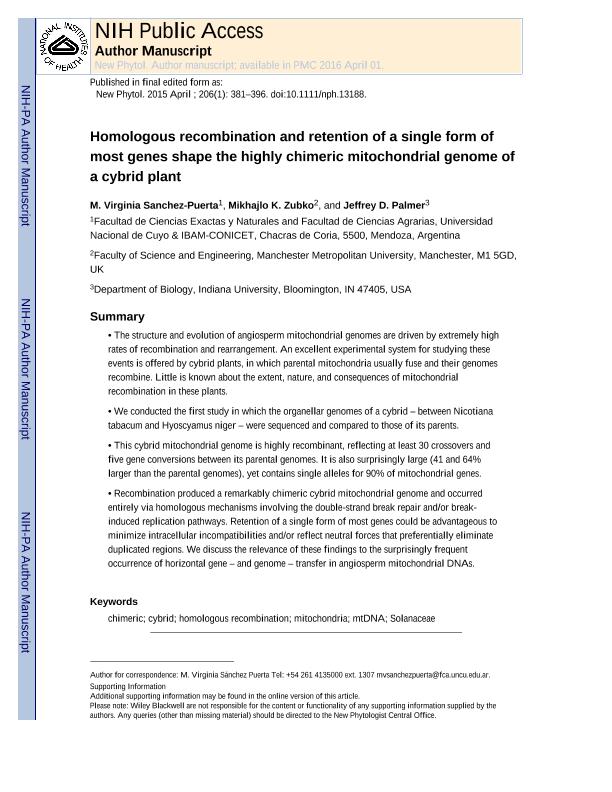Artículo
Homologous recombination and retention of a single form of most genes shape the highly chimeric mitochondrial genome of a cybrid plant
Fecha de publicación:
28/04/2015
Editorial:
Wiley
Revista:
New Phytologist
ISSN:
0028-646X
Idioma:
Inglés
Tipo de recurso:
Artículo publicado
Clasificación temática:
Resumen
The structure and evolution of angiosperm mitochondrial genomes are driven by extremely high rates of recombination and rearrangement. An excellent experimental system for studying these events is offered by cybrid plants, in which parental mitochondria usually fuse and their genomes recombine. Little is known about the extent, nature and consequences of mitochondrial recombination in these plants. We conducted the first study in which the organellar genomes of a cybrid – between Nicotiana tabacum and Hyoscyamus niger – were sequenced and compared to those of its parents. This cybrid mitochondrial genome is highly recombinant, reflecting at least 30 crossovers and five gene conversions between its parental genomes. It is also surprisingly large (41% and 64% larger than the parental genomes), yet contains single alleles for 90% of mitochondrial genes. Recombination produced a remarkably chimeric cybrid mitochondrial genome and occurred entirely via homologous mechanisms involving the double-strand break repair and/or break-induced replication pathways. Retention of a single form of most genes could be advantageous to minimize intracellular incompatibilities and/or reflect neutral forces that preferentially eliminate duplicated regions. We discuss the relevance of these findings to the surprisingly frequent occurrence of horizontal gene – and genome – transfer in angiosperm mitochondrial DNAs.
Palabras clave:
Homologous Recombination
,
Cybrid
,
Evolution
,
Solanaceae
,
Chimeric
,
Mitochondria
,
Mtdna
Archivos asociados
Licencia
Identificadores
Colecciones
Articulos(IBAM)
Articulos de INST.DE BIOLOGIA AGRICOLA DE MENDOZA
Articulos de INST.DE BIOLOGIA AGRICOLA DE MENDOZA
Citación
Sánchez Puerta, María Virginia; Zubko, Mikhajlo K.; Palmer, Jeffrey D.; Homologous recombination and retention of a single form of most genes shape the highly chimeric mitochondrial genome of a cybrid plant; Wiley; New Phytologist; 206; 1; 28-4-2015; 381-396
Compartir
Altmétricas




